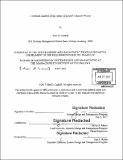A systems analysis of the Army's tactical evaluation process
Author(s)
Caddell, John D
DownloadFull printable version (15.22Mb)
Other Contributors
System Design and Management Program.
Advisor
Bryan R. Moser.
Terms of use
Metadata
Show full item recordAbstract
In preparation to fight and win the nation's wars, the United States Army spends a lot of time and money on tactical training. While few doubt that the Army produces some of the world's finest tactical units, there is still room for improvement. The Army's current tactical evaluation process utilizes a series of subjective and uncalibrated metrics that describe the capability of military units. Leaders fail to see the value in the provided evaluation forms and formats and have begun developing alternative methods to evaluate and provide feedback to their units. The abandonment of a standard evaluation process has added to the inability to objectively or accurately compare units across formations and time. The current evaluation system depends almost entirely on one set of humans to monitor safety, performance, and provide feedback to the training unit for improvement. Humans in this system fatigue and fall prey to natural pressures to reduce standards and push units through training exercises regardless of undesirable performance. Additionally, internal pressure, organizational structure, and competition encourage units to exaggerate or inflate their tactical readiness reports. While this situation is widely recognized in the Army, the current evaluation system results in unreliable, and possibly inaccurate, outputs that are unusable for decision making. As a consequence of this system, the Army maintains very few ways to distinguish between the training levels and capability of tactical units. By examining the organizational structure, individual and unit incentives, and evaluation methods available for the Army to adjust, this document provides a method to compare and evaluate the possible alternatives.
Description
Thesis: S.M. in Engineering and Management, Massachusetts Institute of Technology, School of Engineering, System Design and Management Program, 2017. Cataloged from PDF version of thesis. Includes bibliographical references (pages 88-90).
Date issued
2017Department
Massachusetts Institute of Technology. Engineering and Management Program; System Design and Management Program.Publisher
Massachusetts Institute of Technology
Keywords
Engineering and Management Program., System Design and Management Program.